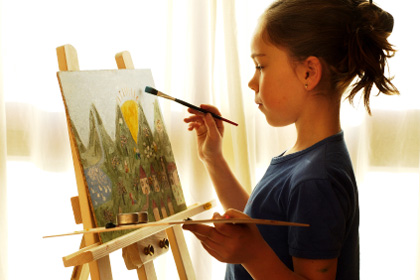 Step into Seattle art therapist Mineko Takada-Dill’s studio and you’ll find an array of paints, clay, pastels, charcoal and textured papers. She uses these materials to help her clients let their guard down and experience the therapeutic benefits of art.
Step into Seattle art therapist Mineko Takada-Dill’s studio and you’ll find an array of paints, clay, pastels, charcoal and textured papers. She uses these materials to help her clients let their guard down and experience the therapeutic benefits of art.
Who hasn’t felt relaxation, focus and a sense of accomplishment while working on a creative project? For a child with special needs, the therapeutic benefits are much greater. Creative arts therapy is a broad field that includes visual arts, music, dance, poetry and drama. The arts are an increasingly popular way for children with special needs to overcome difficulties and take pride in a new skill.
Takada-Dill finds that the visual nature of art therapy is especially beneficial for kids who have trouble communicating in other ways. Some of Takada-Dill’s favorite projects include creating storybooks, masks and collages. This is an effective method for getting kids to identify and deal with difficult emotions such as anger, frustration and sadness.
Music therapy for kids
Children who aren’t as visual may find that music therapy is helpful for improving speech, cognitive development, motor skills and communication. “Music therapy helps children of all ages and disabilities, especially children who are particularly auditory,” says Jennifer Hastings, a Seattle neurologic music therapist.
Though some people may think they need natural talent to play music, Hastings disagrees. “I became a music therapist because I wanted to make music accessible to everyone,” she says.
She has helped make music an approachable way for kids with special needs to gain skills they may not pick up in a traditional school setting, including communication and social skills. Hastings works with several kids who are more comfortable expressing themselves with music rather than verbally. “An improv music session is very similar to the back-and-forth nature of a social interaction,” she says. Anne Powers’ stepdaughter, who has autism, worked individually with a music therapist. Powers, a Lake Stevens mom, saw tremendous gains from the one-on-one attention her stepdaughter received.
“Music kept her very focused and trained her brain to stay on task and filter out distraction,” says Powers. “We saw improvement in her problem-solving ability, frustration tolerance, creative expression and dexterity. She can now play some of her favorite songs and she can express her moods with her playing, something she cannot do verbally.”
Best of all, says Powers, music became part of her stepdaughter’s routine. “Music therapy was absolutely the highlight of her week.”
Children's dance therapy
Music and dance can be a powerful combination. According to the American Dance Therapy Association, dance therapy has been around for more than 50 years and helps connect the body and mind. It’s also effective for individuals with developmental, physical, social, psychological or physiological impairments.
Emerald Ballet Theatre (EBT) in Bellevue offers dance classes for kids with special needs. Today, most of these children are successfully integrated into classes with the other dancers. This gives the “exceptional dancers,” as they call them, a way to interact with others and feel included. “It’s remarkable how well the integration works,” says Sarah Jacobsen, an EBT instructor. “We expect all of our students to strive to be inclusive, and it’s really been worth the effort.”
Amina Condel’s daughter, who is autistic, has thrived during her participation in classes at Emerald Ballet Theatre. “Even though the dance classes are not technically ‘therapy,’ they have been very therapeutic,” says Condel, who reports that her daughter has improved her gross motor function, memory, social skills, speech and cognitive skills. “She loves being a part of the production and feels valued,” she says.
Rosalie Frankel, an arts therapist at Seattle Children’s Hospital, says that finding an arts therapist in Seattle may be difficult compared to other places in the country, but worth the effort. “It’s really beneficial for so many kids.”
Children with disabilities often possess creative gifts that they aren’t able to express until they are put in the right environment. “The arts are a magical place where these kids can really shine,” says Jacobsen.
Chera Prideaux is a Seattle freelance writer and mother.
Creative Arts Therapy Resources for Kids
Mineko Takada-Dill
American Music Therapy Association
Seattle Children’s Hospital
Jennifer Hastings
Emerald Ballet Theatre
Evergreen Art Therapy Association
American Dance Therapy Association









